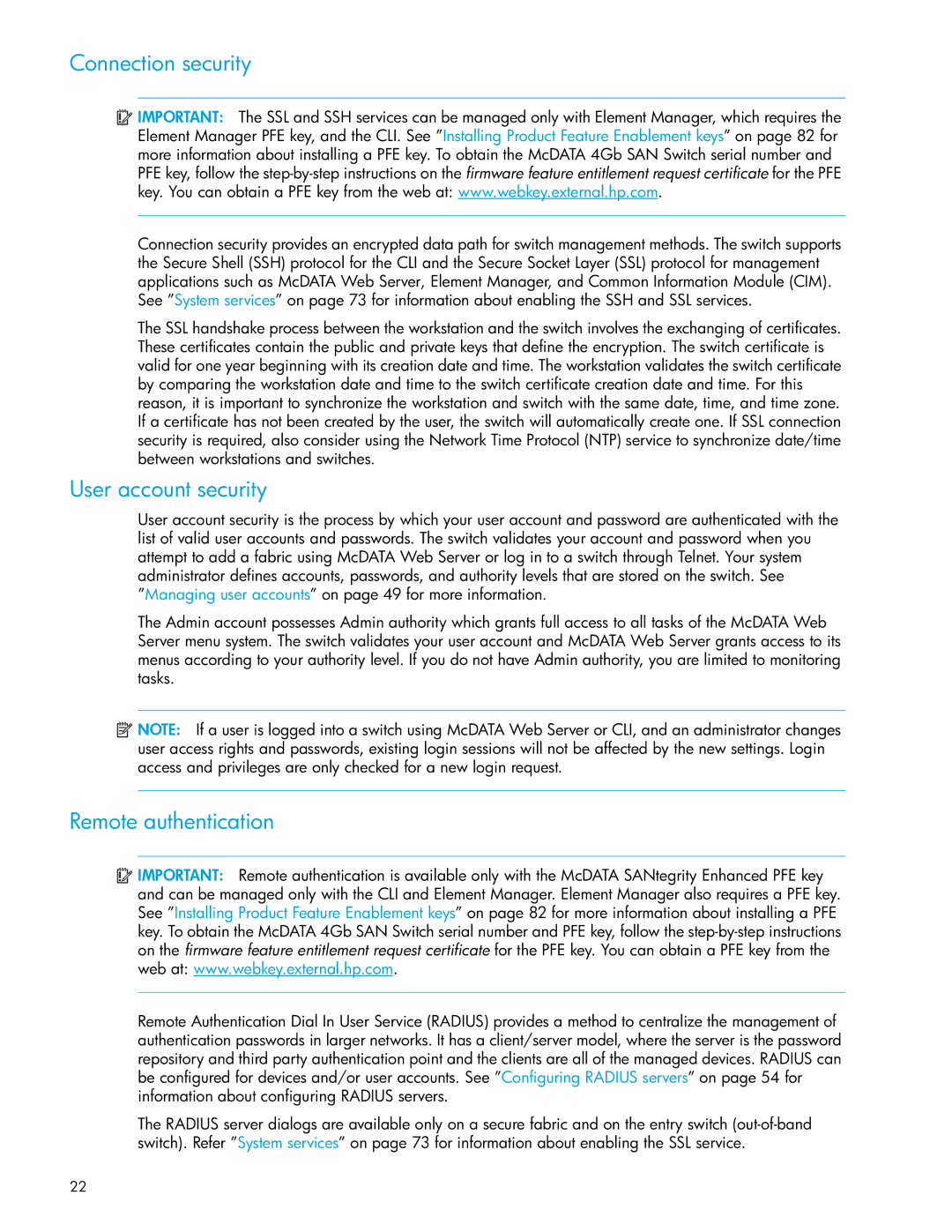
Connection security
![]() IMPORTANT: The SSL and SSH services can be managed only with Element Manager, which requires the Element Manager PFE key, and the CLI. See ”Installing Product Feature Enablement keys” on page 82 for more information about installing a PFE key. To obtain the McDATA 4Gb SAN Switch serial number and PFE key, follow the
IMPORTANT: The SSL and SSH services can be managed only with Element Manager, which requires the Element Manager PFE key, and the CLI. See ”Installing Product Feature Enablement keys” on page 82 for more information about installing a PFE key. To obtain the McDATA 4Gb SAN Switch serial number and PFE key, follow the
Connection security provides an encrypted data path for switch management methods. The switch supports the Secure Shell (SSH) protocol for the CLI and the Secure Socket Layer (SSL) protocol for management applications such as McDATA Web Server, Element Manager, and Common Information Module (CIM). See ”System services” on page 73 for information about enabling the SSH and SSL services.
The SSL handshake process between the workstation and the switch involves the exchanging of certificates. These certificates contain the public and private keys that define the encryption. The switch certificate is valid for one year beginning with its creation date and time. The workstation validates the switch certificate by comparing the workstation date and time to the switch certificate creation date and time. For this reason, it is important to synchronize the workstation and switch with the same date, time, and time zone. If a certificate has not been created by the user, the switch will automatically create one. If SSL connection security is required, also consider using the Network Time Protocol (NTP) service to synchronize date/time between workstations and switches.
User account security
User account security is the process by which your user account and password are authenticated with the list of valid user accounts and passwords. The switch validates your account and password when you attempt to add a fabric using McDATA Web Server or log in to a switch through Telnet. Your system administrator defines accounts, passwords, and authority levels that are stored on the switch. See ”Managing user accounts” on page 49 for more information.
The Admin account possesses Admin authority which grants full access to all tasks of the McDATA Web Server menu system. The switch validates your user account and McDATA Web Server grants access to its menus according to your authority level. If you do not have Admin authority, you are limited to monitoring tasks.
![]() NOTE: If a user is logged into a switch using McDATA Web Server or CLI, and an administrator changes user access rights and passwords, existing login sessions will not be affected by the new settings. Login access and privileges are only checked for a new login request.
NOTE: If a user is logged into a switch using McDATA Web Server or CLI, and an administrator changes user access rights and passwords, existing login sessions will not be affected by the new settings. Login access and privileges are only checked for a new login request.
Remote authentication
![]() IMPORTANT: Remote authentication is available only with the McDATA SANtegrity Enhanced PFE key and can be managed only with the CLI and Element Manager. Element Manager also requires a PFE key. See ”Installing Product Feature Enablement keys” on page 82 for more information about installing a PFE key. To obtain the McDATA 4Gb SAN Switch serial number and PFE key, follow the
IMPORTANT: Remote authentication is available only with the McDATA SANtegrity Enhanced PFE key and can be managed only with the CLI and Element Manager. Element Manager also requires a PFE key. See ”Installing Product Feature Enablement keys” on page 82 for more information about installing a PFE key. To obtain the McDATA 4Gb SAN Switch serial number and PFE key, follow the
Remote Authentication Dial In User Service (RADIUS) provides a method to centralize the management of authentication passwords in larger networks. It has a client/server model, where the server is the password repository and third party authentication point and the clients are all of the managed devices. RADIUS can be configured for devices and/or user accounts. See ”Configuring RADIUS servers” on page 54 for information about configuring RADIUS servers.
The RADIUS server dialogs are available only on a secure fabric and on the entry switch
22
